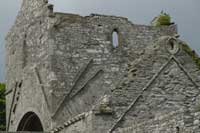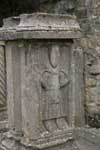
Travelogue
Photos
Today
Corlea Trackway
Ballinamore Castle
Abbeyderg Friary
Bawn Castle
Boyle Abbey
Lough Arrow
Sligo Abbey
Temple House
Travelogue, Day 21
One of the things we often have problems with is "forward momentum", despite our one-night-at-a-time accommodation model. We get wrapped up in the hundreds of things to see in one area and end up going backwards. It's Mark's job to keep us moving forward in our trek around Ireland. We don’t' really have an itinerary -- but a general idea of "well, we're 3/4 of the way through things, we should be in Sligo, at least" is enough of a guide.
So, our goal is Sligo tonight and we confidently set off in that directory. Sort of. I saw a sign for the Corlea Trackway center and we spent an hour and a half (at least) wandering around the bog, the visitor's center, ad peering at the excavated and rebuilt iron age bog road. The planks of oak are fitted and pegged into a long roadway that crossed the peat bog near Longford. It's assumed they were for trade, and the roadway is wide enough and strong enough to support car traffic.
We were the only people at the site and the guy manning the desk was more than happy to wander around with us, show us plants in the bog, and explain all about the archeology and stabilization work on the roadway. It was fascinating. We even saw some teensy little venus flytrap plants - big enough to catch gnats, maybe. There is a "new" bog road built outside the visitor's center that continues the path of the ancient road out into the bog. There are warning signs everywhere not to leave the pathways --apparently it's quite common for plant matter and moss to skin over the top of a deep pool of water, so that it looks solid enough, but there is really just an inch or so floating on the top. You can plunge into these bog pools very easily and blup! You are stuck, since the sides of the pool aren't solid enough to climb out.
 Peat bogs come in two flavors - the blanket type, which is just layers and layers of peat over the rocks and stones, and an actual bog, which fills in with water like an enormous, gloopy sponge that is mostly water and very little actual solid land. They are quite dangerous (don't go wandering out into areas identified as bogs, or you may end up needing rescue!
Peat bogs come in two flavors - the blanket type, which is just layers and layers of peat over the rocks and stones, and an actual bog, which fills in with water like an enormous, gloopy sponge that is mostly water and very little actual solid land. They are quite dangerous (don't go wandering out into areas identified as bogs, or you may end up needing rescue!
A couple of casual view of castles from road today - Ballinamore and Bawn. We had a plan today, hah!
More abbeys and burial grounds
We tracked down Abbeyderg friary based on the sign by the road (it's nearby, but dang it is it hard to find if you miss the first turnoff). There isn't much to see here, even though it was marked with a star in the Rough Guides map. The church is in ruins and no high crosses or anything in the churchyard.It's a pretty walk through the grounds, though, with various headstones and mausoleums. A paved path around the whole site is a very nice walk.
Boyle Abbey is much more complete and sagging gracefully on the wall of the church. The aisle of the church is lovely. The walls are highly decorated, which is unusual for a monastery. There are several styles of columns in the nave of the church: early ones are found headed with round columns, then octagonal columns, then gothic arched tops and rounded columns, then gothic arches with multi-stemmed arches -- all in the space of a couple dozen yards. It's obvious that things were build in stages and it must have taken a long time. That's surprising, really. Most of the abbeys that we've seen have been remarkably homogenous, this one really shows multiple stages of building very clearly. Either other monasteries just kept building in the same style, or they were build in a shorter time period.
 It's always interesting to see how things have changed. Just looking at the tower of this abbey it's possible for see four or five different roof lines (no roof, of course) as the abbey progressed. Windows are blocked in, reopened, filled in all over the site. The ornate,multi-arched bases of doorways (or windows?) that are cut off as stubs near the ground, with the openings filed in with rough rubble. The arches in the aisle of the church are all filled in with thick walls, while the real outer wall of the church is long gone, it seems. The walls are leaning outward at a perilous angle , but the capitals of the columns along the church have a variety of carved figures: animals, flowers, weird googly-eyed little people.
It's always interesting to see how things have changed. Just looking at the tower of this abbey it's possible for see four or five different roof lines (no roof, of course) as the abbey progressed. Windows are blocked in, reopened, filled in all over the site. The ornate,multi-arched bases of doorways (or windows?) that are cut off as stubs near the ground, with the openings filed in with rough rubble. The arches in the aisle of the church are all filled in with thick walls, while the real outer wall of the church is long gone, it seems. The walls are leaning outward at a perilous angle , but the capitals of the columns along the church have a variety of carved figures: animals, flowers, weird googly-eyed little people.
We're on an abbey loop today, apparently, and decided to try a run for Sligo before stopping for the day. We stopped along the way to view the beautiful scenics at Lough Arrow and then skidded into Sligo to see the abbey only a few minutes before they were slated to close. The caretakers very kindly offered us a tour anyway (I think it had been a slow day). One of the first things we noticed is that the abbey is completely walled in on a residential block -- from the outside, the walls are seven to ten feet, but inside the churchyard, the ground level is several feet higher. Why? Because they buried so many people in the churchyard during ga cholera epidemic and famines that they had to import dirt to keep covering the bodies. People would juts leave the bodies here, so the monks laid them out like cordwood, covered them with a little lime and dirt, and put the next group right over the top. They brought in so much dirt to cover the bodies (and has so many bodies) that the ground level inside is probably six feet higher now.
Eeuuu!
The guide says that they are probably ten thousand people buried here since the abbey yard was built. And here I was worried about treading on gravestones…I should be more squicked out by treading on layer after layer of bodies.
 Despite the unusual burial arrangements, the abbey at Sligo is nearly complete and quite beautiful. The cloister is almost complete. Most of the time, only a few of the arches remained, and very rarely a section of the roof. This is all reconstructed, of course, but this is the first abbey that is so complete and easy to walk through. It's quite small, and compressed into the limited space it currently has. It's likely that this was originally an enormous collection of buildings.
Despite the unusual burial arrangements, the abbey at Sligo is nearly complete and quite beautiful. The cloister is almost complete. Most of the time, only a few of the arches remained, and very rarely a section of the roof. This is all reconstructed, of course, but this is the first abbey that is so complete and easy to walk through. It's quite small, and compressed into the limited space it currently has. It's likely that this was originally an enormous collection of buildings.
On the Family Estate
We found an absolutely fabulous B&B for the night -- Temple House, which was recommended by everyone. Wow. We had dinner at the big dining table with the rest of the guests for the night, which was fun, then sat in the "morning" room and talked until midnight. A couple from England (he was a marine biologist and she was a social worker), and a family from N. Ireland celebrating a birthday and anniversary were also there. It was a neat group.
Our room is absolutely ENORMOUS. Seriously - 25 x 25 x 15, at least. AND, it has a separate sitting room with another single bed before leading to the huge paneled bathroom. They call it"the little acre". The house is glorious, and in a constant state of repair according to the owner (who oversees the dinners, etc). There are 97 rooms in the house, and really on ly the left wing, with six rooms let out for lodgers, is really finished. The other part of the house is falling apart, in some cases -- no plaster remains, floors are sagging, windows aren't in place, they say that some of the building isn't really structurally sound, but they're fixing rooms as they can and intend t open a few more rooms for B&B soon. They have 1000 acres of land, including the ruin of the original Percival castle, and their own lake. The house has been in the family for over 200 years.
I can only imagine growing up "on the family estate" with the same house and same buildings that your family has had for centuries. I can't decide if it would be stifling - the need to conform to the family history and continue the family estates -- or if it would be incredibly cool to grow up with that amount of family ephemera.
Or maybe I really just want to own a castle.